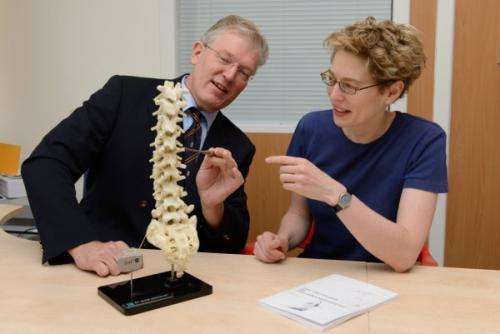There are about a million people in the Netherlands with diabetes. Approximately 15% of these patients suffer from chronic pain. This is burning or stinging pain caused by abnormal function of nerve endings, most likely partially due to poor circulation. Cecile de Vos, PhD student at the University of Twente and a medical physicist working at Medisch Spectrum Twente hospital, studied the effect of spinal cord stimulation treatment which had not been applied to these patients. De Vos: "The new method shows great promise for diabetics. Due to the treatment, the pain intensity has decreased from an average of eight to two and the pain has become manageable. Diabetic patients are able to sleep again and perform their daily activities. This has greatly improved their quality of life."
De Vos conducted international doctoral research in recent years at the Department of Neurosurgery in Medisch Spectrum Twente hospital. She studied a new treatment option for pain as a result of diabetes mellitus. Diabetic neuropathic pain (abbreviated: DNP) is usually described as a burning or stabbing pain, especially in the feet and lower legs, sometimes in the hands, which is present throughout the day, but often fiercest in the evening or at night. For the majority of patients, DNP is difficult to treat with painkillers. This prompted the research into whether spinal cord stimulation could provide results for patients suffering from DNP.
Spinal cord stimulation is a treatment to reduce pain in which spinal cord nerves are stimulated by electrical pulses. For spinal cord stimulation, the physician implants a stimulation electrode in the epidural space (the outermost part of the spinal canal). A pulse generator which has been implanted subcutaneously delivers electrical stimulation pulses. The system appears similar to a pacemaker, only the pulses are transmitted to the spinal cord nerves rather than the heart. Stimulating the nerves ensures that the pain signals which, for example, are transmitted from the foot, are felt much less or not at all. According to De Vos, spinal cord stimulation has been used in the Netherlands for many years for patients who, for example, have difficult to treat pain after back surgery, but it had not yet been used to treat DNP.
This is why Medisch Spectrum Twente began a major research project and De Vos and neurosurgeon Mathieu Lenders asked other hospitals in the Netherlands, Belgium, Germany and Denmark to participate. A total of 60 patients with DNP have participated in the study. According to their referring doctors, these patients could not be treated further for their DNP. However, they still had an average pain score of 8 on a scale from 0 to 10 (0 being no pain, 10 being the worst pain imaginable).
Patients participating in the study were divided into two groups: a spinal cord stimulation group and a control group in which the patients received all of the standard treatment and care. The patients who received a spinal cord stimulator had far less pain after a month; decreasing from an average of eight to two. The pain relief also remained in the six months thereafter. Among the patients who had not been given a spinal cord stimulator (the control group), there was, on average, no decrease in pain.
The doctoral research of Cecile de Vos MSc, medical physicist at Medisch Spectrum Twente, was carried out as part of the research at MIRA, University of Twente research institute, Faculty of Science and Technology (TNW). The thesis on spinal cord stimulation for the treatment of neuropathic pain is available by request.
Provided by University of Twente


















